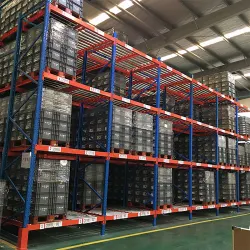Here are key features and considerations related to gravity flow racks
2023-12-28
Gravity flow racks, also known as gravity flow shelves or gravity flow systems, are storage solutions designed to optimize the flow of goods and materials within a warehouse or distribution center. These racks utilize the force of gravity to move items from a higher elevation to a lower one, allowing for efficient and organized storage and retrieval. Gravity flow racks are commonly used in settings where there is a need for high-density storage and quick access to items. Here are key features and considerations related to gravity flow racks:
1. Flow Rack Structure:
- Roller Tracks or Conveyor Rollers: Gravity flow racks are equipped with roller tracks or conveyor rollers on inclined shelves to facilitate the smooth movement of items.
- Flow Lanes: The racks typically have multiple flow lanes, each designed to accommodate a specific type of product or SKU (Stock Keeping Unit).
2. Inclined Design:
- Gravity Feed: The shelves are inclined to allow products to move from the back of the rack (loading side) to the front (picking side) through the force of gravity.
- Rear Loading, Front Picking: Products are loaded at the rear of the rack and are automatically conveyed toward the front for easy picking.
3. Carton Flow Systems:
- Roller Tracks with Wheel Beds: Some gravity flow racks use carton flow systems, where products are placed on wheeled beds or tracks that allow them to flow smoothly to the front.
- First-In-First-Out (FIFO): Carton flow systems facilitate a FIFO inventory management system, ensuring that the oldest items are picked first.
4. Benefits:
- High-Density Storage: Gravity flow racks maximize vertical space and provide high-density storage, making them suitable for warehouses with limited floor space.
- Improved Accessibility: Items automatically move to the front of the rack, providing easy access for picking and reducing the need for manual handling.
- Increased Efficiency: Gravity flow racks enhance order picking efficiency and reduce the time spent searching for items.
5. Applications:
- Order Picking Systems: Gravity flow racks are commonly used in order picking systems, especially in e-commerce and distribution centers.
- Assembly Lines: Gravity flow racks can be integrated into assembly lines to provide a steady supply of components or parts.
- Manufacturing: Used for storing and moving raw materials or work-in-progress items in manufacturing environments.
6. Configurations:
- Single-Depth Flow Racks: Products flow on a single level, typically with one picking aisle.
- Double-Depth Flow Racks: Stacked back-to-back, allowing for higher storage density and multiple picking aisles.
- Dynamic Flow Racks: Designed for fast-moving items, dynamic flow racks use dynamic lanes to facilitate continuous product flow.
7. Adjustability:
- Configurable Lanes: Gravity flow racks often allow for adjustable lane configurations, enabling the customization of storage for different product sizes and shapes.
8. Safety Features:
- Brakes and Speed Controllers: Some gravity flow racks include brakes or speed controllers to regulate the flow of items and prevent them from moving too quickly.
- Anti-Tilt Systems: Designed to prevent products from tilting or jamming during flow.
9. Integration with Automation:
- Automation Compatibility: Gravity flow racks can be integrated into automated systems, such as conveyor systems or robotic picking solutions, to further enhance efficiency.
10. Maintenance:
- Regular Inspection: Regular maintenance and inspection are important to ensure that the rollers or tracks are in good condition and that the system operates smoothly.
Gravity flow racks are versatile storage solutions that contribute to efficient order fulfillment, reduced picking times, and effective space utilization in warehouse and distribution environments. Their design promotes a continuous flow of goods, making them well-suited for applications where quick and organized access to items is essential.



